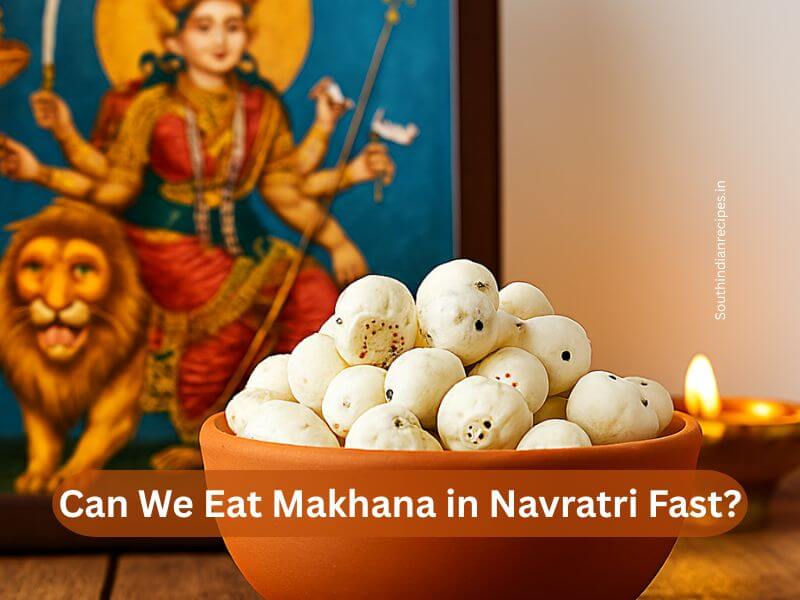Navratri — the nine nights dedicated to Goddess Durga — is a time of devotion, discipline, and sattvik living. Fasting during this period is not just a religious ritual; it’s a way to cleanse the body, focus the mind, and elevate the spirit. Among the many vrat‑friendly foods, makhana (fox nuts or lotus seeds) has become a popular choice. But the question remains: Can we eat makhana in Navratri fast? Let’s explore the answer through tradition, nutrition, and expert insights.
Contents
While Navratri fasting food lists vary by region and family tradition, the general vrat guidelines include:
- Avoiding grains like wheat and rice (except vrat flours such as kuttu, singhara, or rajgira atta).
- Eliminating onion, garlic, and non‑vegetarian foods.
- Using sendha namak (rock salt) instead of regular salt.
- Focusing on sattvik foods — fresh fruits, dairy, nuts, and certain vegetables.
Some devotees follow a phalahar diet (fruits, dry fruits, and milk only), while others include light sattvik meals once or twice a day.
Yes — in most traditions, makhana is allowed in Navratri fast because:
- It is a natural seed and considered sattvik (pure and light).
- It contains no grains, onion, garlic, or processed additives.
- It is easy to digest and provides sustained energy during fasting hours.
Makhana is often roasted with sendha namak for a crunchy snack or cooked into makhana kheer for a sweet vrat treat.
Including makhana in vrat diet offers multiple health benefits:
- Energy Booster: Rich in carbohydrates and protein for steady energy release.
- Mineral Rich: Contains magnesium, potassium, and phosphorus to maintain electrolyte balance.
- Weight‑Friendly: Low in calories and high in fiber, keeping you full for longer.
- Antioxidants: Help reduce oxidative stress and support overall health.
- Digestive Support: Light on the stomach and easy to digest during dietary changes.
Expert Insights
- Ayurvedic View: Makhana is considered madhura rasa (sweet taste) and laghu guna (light quality), which balances Vata and Pitta doshas during fasting.
- Nutritionist’s Advice: “Makhana is an excellent vrat snack. Roast it in ghee with rock salt for a healthy, crunchy option,” says Ritu Sharma, Clinical Nutritionist.
- Cultural Note: In many households, makhana is used in vrat recipes like makhana curry, makhana kheer, and dry roasted makhana mix.
- Roasted Makhana: Dry roast in ghee with sendha namak for a light snack.
- Makhana Kheer: Cook in milk with cardamom and dry fruits for a sweet dish.
- Makhana Curry: Combine with vrat‑friendly vegetables in a light gravy.
- Trail Mix: Mix roasted makhana with almonds, cashews, and raisins.
Precautions
- Makhana is healthy, but moderation is key — overconsumption may cause bloating.
- Choose unpuffed, preservative‑free makhana for purity.
- For diabetics, pair makhana with protein or healthy fats to balance blood sugar.
Frequently Asked Questions – (FAQs)
Ans: Yes, makhana is vrat‑friendly, sattvik, and provides energy during fasting.
Ans: It offers protein, minerals, fiber, and antioxidants — ideal for fasting.
Ans: Roast with ghee and rock salt, make makhana kheer, or add to vrat curries.
Ans: Yes, but in moderation and preferably paired with nuts or dairy for balanced sugar release.
Que 5. Is Makhana Heavy to Digest During Fasting?
Ans: No, makhana is light and easy to digest, making it perfect for vrat meals.
Also Read: Can We Eat Dry Fruits in Navratri Fast? – A Complete Guide
Bottom Line
For most devotees, makhana is allowed in Navratri fast and is a wholesome, sattvik choice that provides energy, nutrition, and variety. Whether roasted, cooked in milk, or added to curries, makhana can make your vrat meals both delicious and nourishing.







